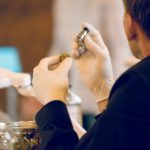
Recently CannaReps held a seminar dedicated to the endocannabinoid system due to the high demand from our participants. We were graced with a very special visit from Professor Nick Inglis, a biology professor and Ph.D. at Kwantlen Polytechnic University. He collaborated with our experts and workshop leader to provide a highly informative seminar on the inner workings and many misconceptions of the endocannabinoid system in the human body. This topic is all the rage within the cannabis community, and so it should be! Such a fascinating and intricate system oftentimes leaves us with more questions and curiosities the deeper we go!
This post outlines the 4 biggest misconceptions regarding the endocannabinoid system that is frequently perpetuated within the media or online. Number 3 is especially interesting!
“The endocannabinoid system evolved in the human body due to the long standing use of cannabis by humans”.
The endocannabinoid system was discovered by retracing the metabolic pathway of cannabinoids. Hence the name: the endocannabinoid system. It’s not, however, because these particles specifically to interact with cannabinoids like THC and CBD. Cannabis and humans did not evolve symbiotically!
Likewise, “endogenous cannabinoids” are not actually cannabinoids made by the body, but rather, are endogenous particles that were discovered by studying the way cannabinoids are assimilated by the body.
Similarities in the molecular structure do exist between some cannabinoids and these particles produced within the human body; Anandamide and AG2 are the two primary endocannabinoids, with anandamide shaped similarly to THC and AG2 sharing some similarities with CBD.
“THC binds to CB1 receptor sites and CBD binds to CB2 receptor sites”
CBD does not have a great affinity to either CB1 or CB2 receptor sites. It binds primarily with secondary receptor sites like GABA receptor sites and countless others. Though THC does bind primarily to CB1 receptor sites, generally speaking, THC and CBD have a lower affinity to receptor binding than their endogenous particles. Anandamide binds almost exclusively to CB1 receptor sites and AG2 binding to both CB1 and CB2 sites. In fact, the majority of the binding occurs through the interaction of cannabinoids with these endogenous particles.
THC increases the potential for anandamide to bind to CB1 sites, and CBD increases the potential for AG2 to bind to CB1 and CB2 receptors while also “hitching a ride” with other particles in order to bind to secondary sites.
So you see, it is not as easy as thinking of endocannabinoids as keys that fit into a particular lock. The process is often explained like this for the sake of simplicity, but in reality, the process is actually much more complicated.
“Cannabinoids are only found in the cannabis plant.”
Hops (used primarily used as a flavouring and stability agent in beer) and several other relatives of the cannabis plant contain cannabinoids that interact with the endocannabinoid system. It is even theorized that these types of particles may exist in many different types of distant relatives as well as other plant lineages that may not yet be thoroughly studied.
“CB1 receptors are in the brain and CB2 receptors are found in the body and white blood cells”.
CB1 receptors are found anywhere that neurons are found, as they tend to be in the area directly adjacent to the synaptic cleft. In recent years we have found neurons and CB1 receptors all throughout the body. Some aspects of the thinking process occur in the gut and in some major organs. Meaning all of those sites will also have some CB1 receptors. There is no doubt that the greatest concentration of CB1 receptors is in the brain, but it is incorrect to say that they are only located in the brain.
Likewise, CB2 receptors are found in the highest concentrations specifically in the peripheral nervous system, on gland cells (a specific type of white blood cell) and in major organs like the liver and the heart. Many of these same organs also contain CB1 receptor sites. Thus, it is clear that the mainstream depiction of the endocannabinoid system is overly simplified. The reality is much more complicated than originally thought. We must always keep that in mind.
The study and field of the endocannabinoid system are quickly and constantly changing with new studies and publications coming forward on a regular basis. CannaReps works to connect our students directly with the world of academic research and aims to guide students in methods of interpreting publications. Deciphering the jargon and pulling apart the arguments made in publications of this nature is a heavy task and ideally should be left to the pros.
It is great for budtenders to draw inspiration from this research and to inspire others through what they know – but it is crucial to stay grounded and not overextend our current state of understanding on this topic. We are still in the early stages of understanding the subtle complexities of the subject. It is key to not say too much as information is evolving at such a fast pace, the public may have difficulty keeping up! Bear in mind that discussing these topics in depth with a customer should not necessarily be the main focus of any budtender, as the subject requires a great deal of specialization and consistent upkeep with scientific publications and complex literature.
MORE FROM THE BLOG





WAIVER & RELEASE (the “Release”)
This event is conducted by CannaReps Consulting Ltd. (“CannaReps or Company”). Please read and submit below.
I am an attendee at an event hosted by CannaReps (the “Workshop“). I release CannaReps from any and all liability, claims, demands, actions and causes of action whatsoever arising out of or related to any loss, damage or injury, including death, that may be sustained by me while participating in the Workshop.
I understand and agree that:
CONFIDENTIALITY
Any confidential or proprietary information or material relating to the Company’s operations or business which I obtain from the Company or its officers, employees, agents, suppliers or customers or otherwise by virtue of my participation with the Company or by the Company’s predecessor. Confidential or proprietary information or material includes, without limitation, the following types of information or material, both existing and contemplated, regarding the Company or its parent, affiliated or subsidiary companies: corporate information, including contractual licensing arrangements, plans, strategies, tactic, policies, resolutions, patents, trademarks, printed or digitized materials, handouts and brochures. Including any marketing information including sales, investment and product plans, customer lists, strategies, methods, customers, prospects and market research data. Including trade secrets; technical information, including drawings, designs, personal information (the “Confidential Information”).
I understand that the copyright and proprietary interest of any material provided to me belongs to CannaReps. All shared experiences from the Workshop are to remain confidential and private. I agree not to disclose any of the information learned during the Workshop outside of the Workshop except with others who attend the Workshop. I will not use any audio or video recording equipment during the Workshop, unless CannaReps approves of the recording and filming by providing prior written consent. I understand that any audio or video recording made during the Workshop is the property of CannaReps. I will not use CannaReps’ information for business or commercial purposes, without first obtaining the prior written consent of CannaReps.
INTELLECTUAL PROPERTY
I understand, acknowledge and agree that all copyright, trademarks, trade secrets, intellectual property rights, and any other rights arising from any designs, and all of the work products and materials conceived, developed or created by the CannaReps and any rights ancillary thereto (collectively, “Intellectual Property Rights”) which were solely or jointly with others, conceives, designs, creates, derives, develops or makes in the course of or in connection with the work with CannaReps shall belong solely to CannaReps. If you haven’t already, you shall promptly disclose to CannaReps in writing any and all Intellectual Property Rights, conceived, created, derived, developed or made in the course of or otherwise in connection with my participation with CannaReps, whether alone or with others, and whether during work shop hours or through the use of facilities and properties of CannaReps.
INDEMNITY
I agrees to indemnify and hold harmless CannaReps, its officers and directors, employees and its affiliates and their respective successors and assigns and each other person, if any, who controls any thereof, against any loss, liability, claim, damage and expense whatsoever (including, but not limited to, any and all expenses whatsoever reasonably incurred in investigating, preparing or defending against any litigation commenced or threatened or any claim whatsoever) arising out of or based upon any false representation or warranty or breach or failure by me to comply with any covenant or agreement made by me herein or in any other document furnished by me to any of the foregoing in connection with this transaction.
CONSENT
Notwithstanding the immediately preceding paragraph, I consent to and grant CannaReps, the Workshop, and its assignees, the right to photograph and record me, my name, voice, appearance and likeness and other material furnished by me for use on trusted online media which include, but are not limited to, their website and social media pages. My hereby release said matter in perpetuity to CannaReps without prejudice and acknowledge that this consent is freely given without expecting compensation.
By submitting my email address below, I agree to receive electronic communication from CannaReps including personal course information, news, updates and promotions regarding CannaReps’ products. I understand that I can withdraw my consent at any time.
PRIVACY POLICY
Protecting your privacy is important to CannaReps. This Privacy Policy (“Privacy Policy”) set outs the ways in which we use your information and how we ensure its protection.
CannaReps will only collect personal information (“Information”) that will allow us to provide, enhance, market or improve our events and services. Information is collected by means of registration for any CannaReps sponsored event or service. Information collected may include name, age, gender, address, email address, payment information, and geographical information.
CannaReps may share Information. CannaReps retains the right to share Information and other statistics with our partners, prospective advertisers, and other third parties for the purposes of improving, protecting, enhancing, and promoting our events and services. CannaReps may also disclose information to our affiliates, agents, contractors, and service providers in order to facilitate the functioning and maintenance of our events and services. We will not sell any information to advertisers or other third parties.
This Privacy Policy only covers the treatment of Information and other non-identifiable information gathered by CannaReps. This Privacy Policy does not apply to the practices of any third-party services. CannaReps does not take responsibility for the content or privacy policies of any third parties. CannaReps recommends that you review the privacy policies of any third-party service providers or events you access, use, or register for through our events or services.
This Privacy Policy has been established to help you understand our commitment to protecting your privacy. CannaReps reserves the right, at any time, to change or replace any portion of our Privacy Policy. You will be notified of any changes, if we believe, they materially impact your experience at our events or services. Continued use of our services after any change to the Private Policy constitutes an acceptance of those changes.
By submitting this Release and providing Information during the registration process, including the Exhibitor’s Agreement, you consent to the collection and use of your Information for these purposes.
If you have any questions or concerns please email us at info@cannareps.ca.